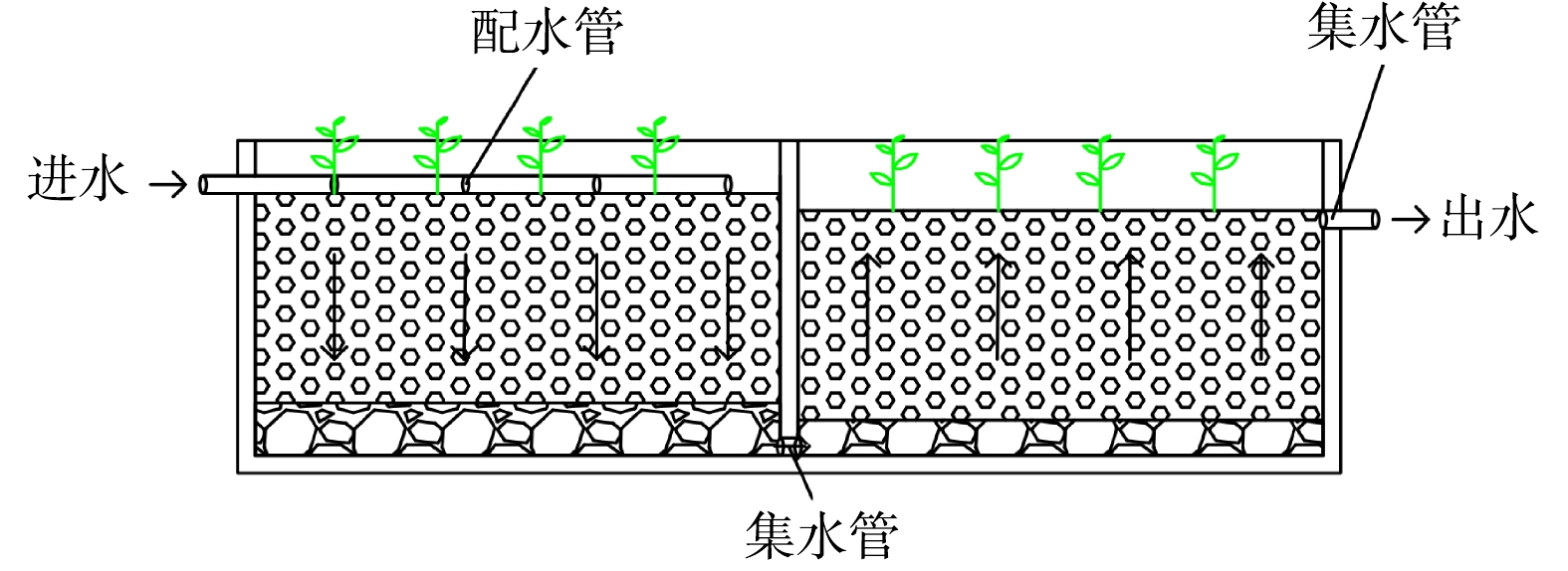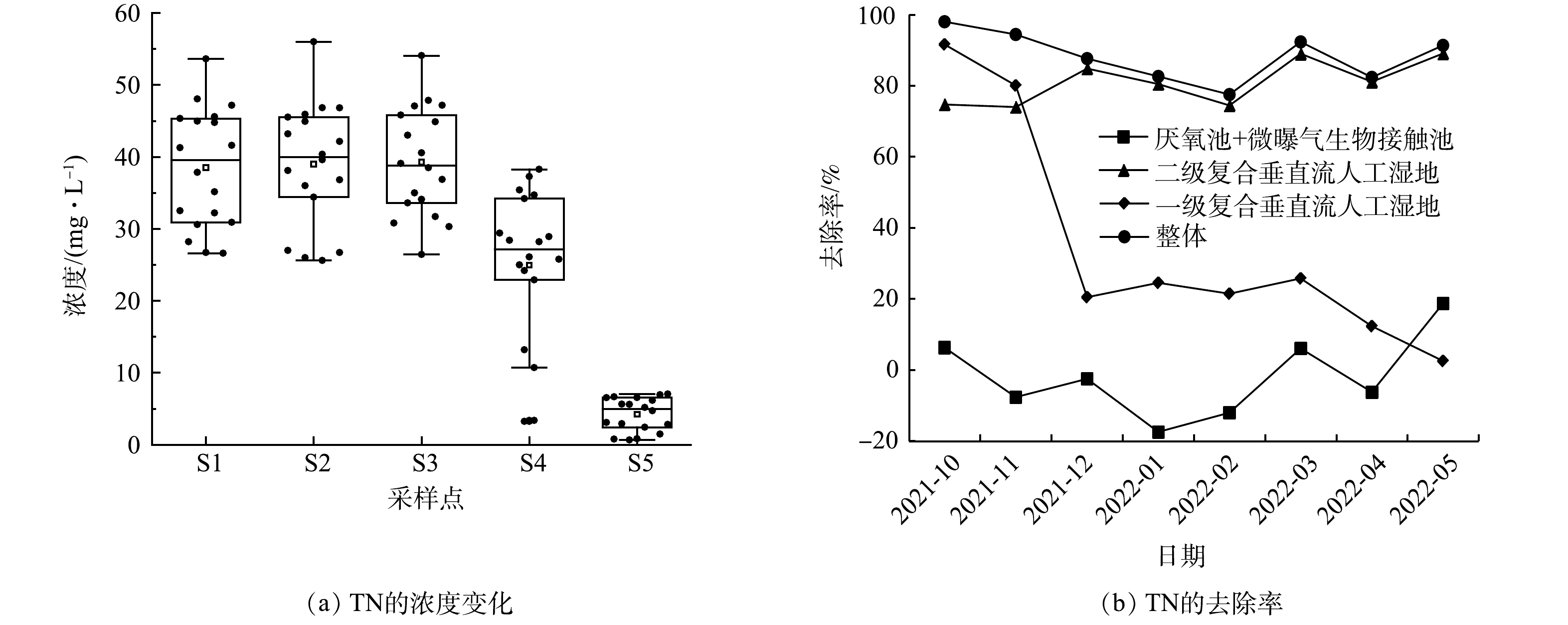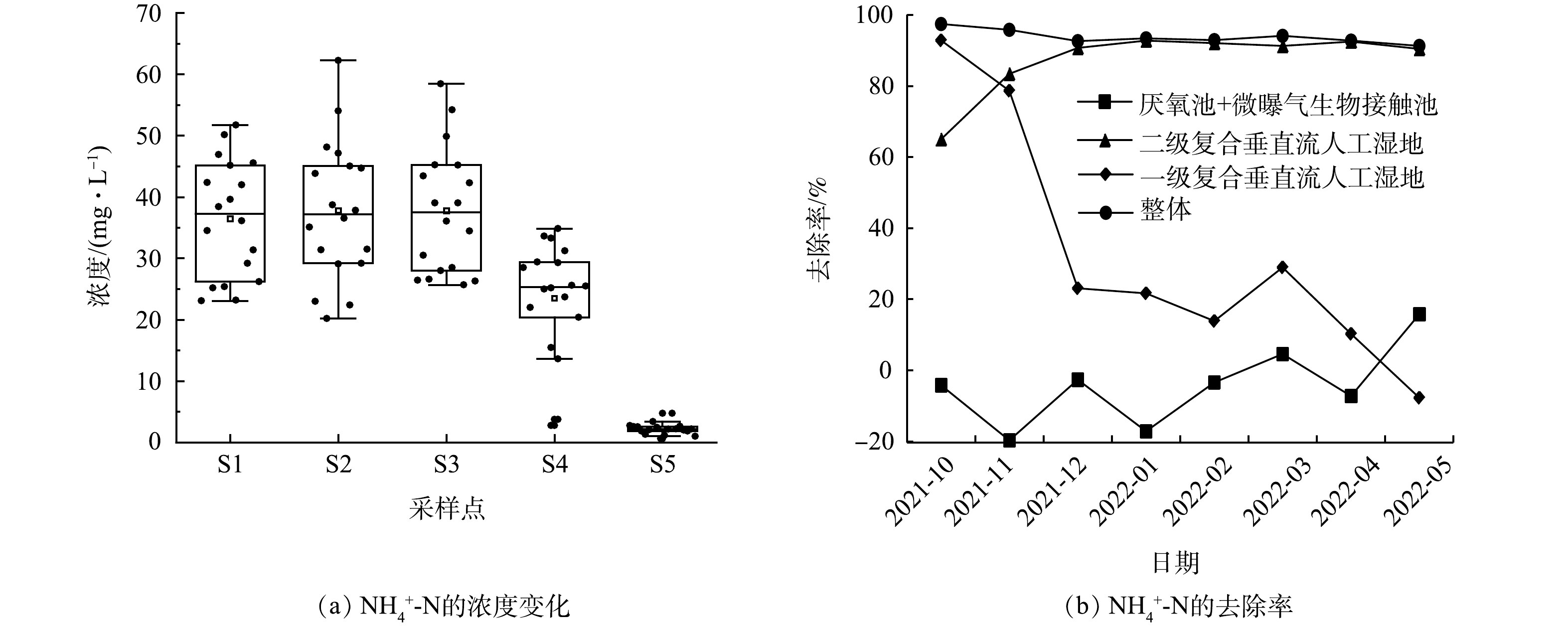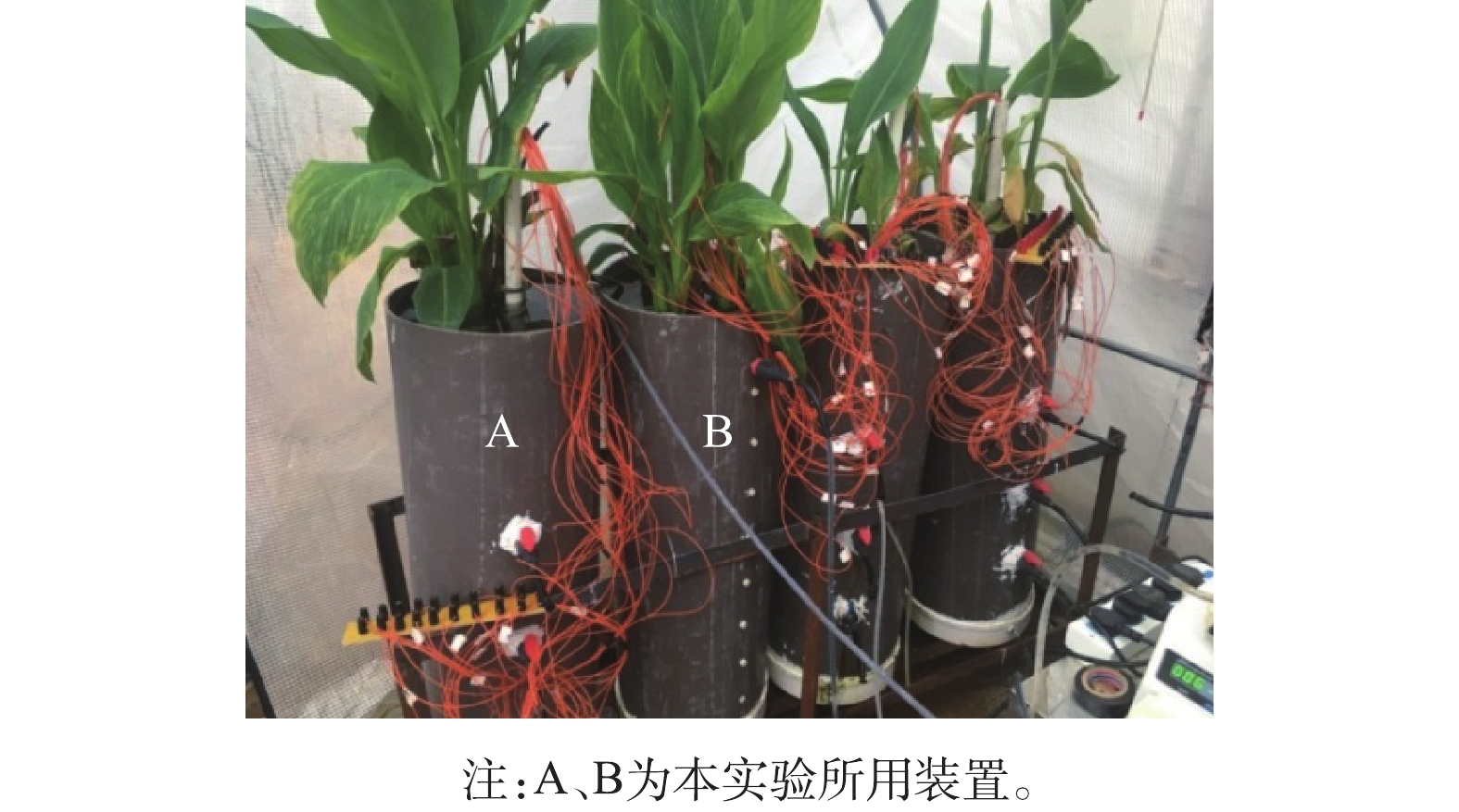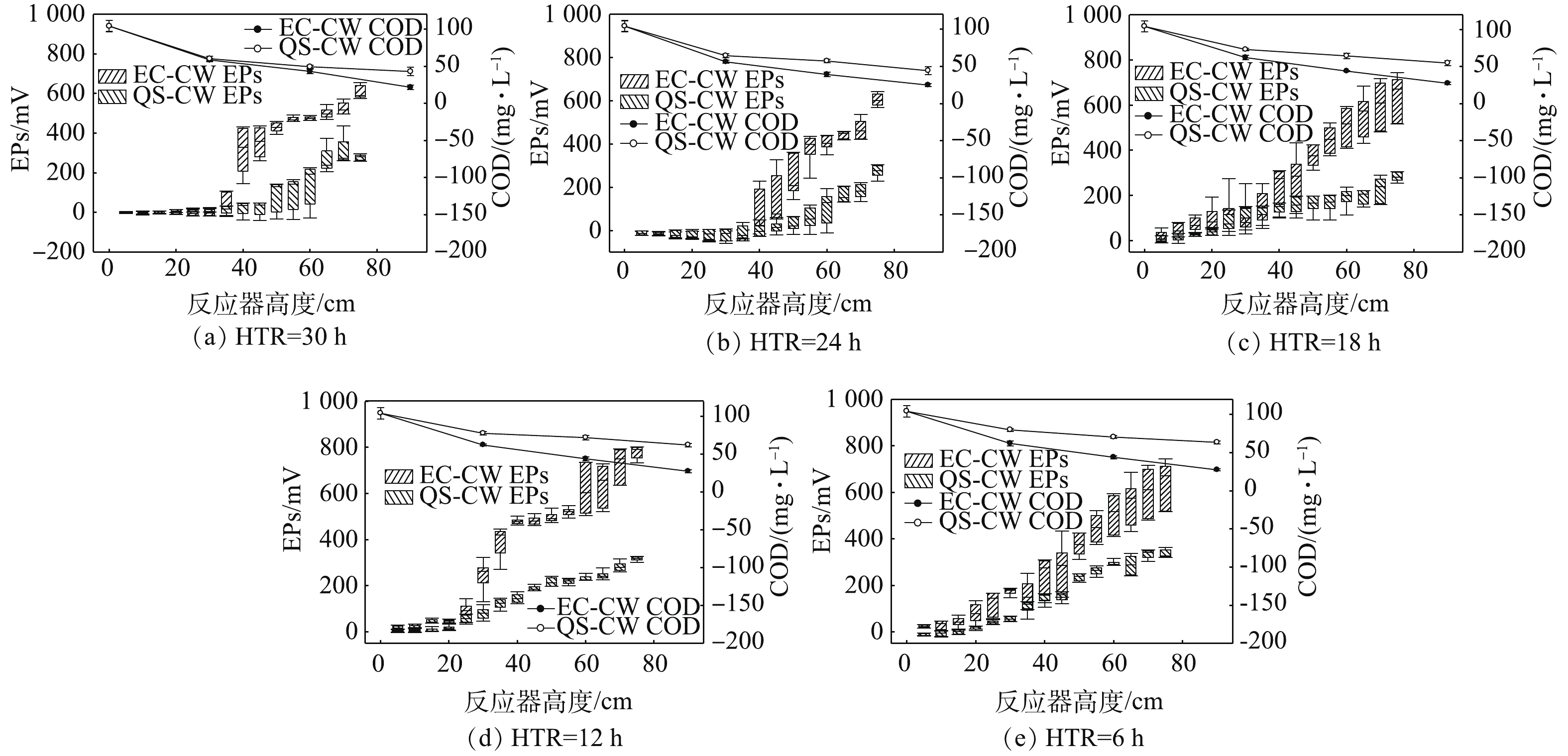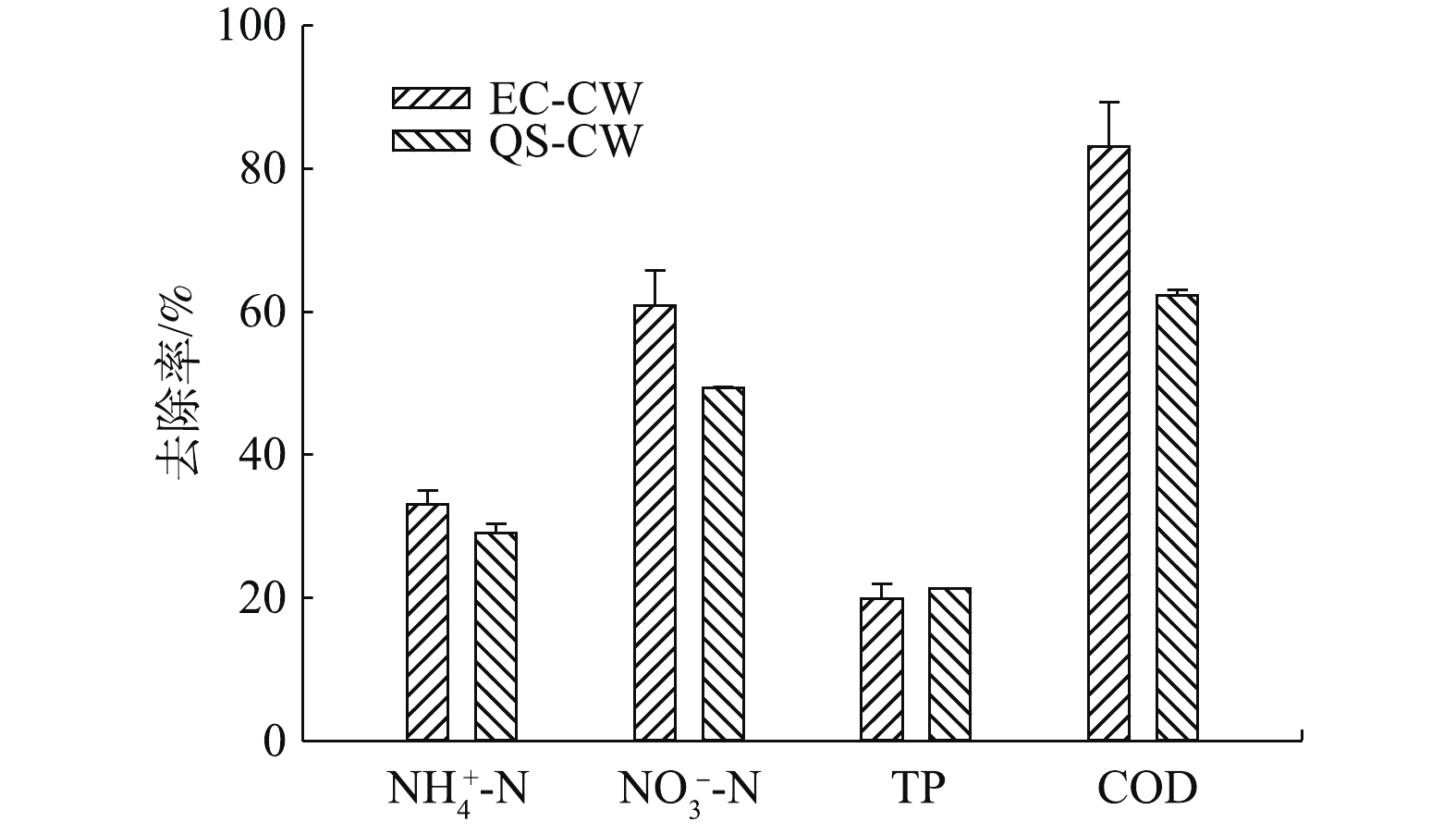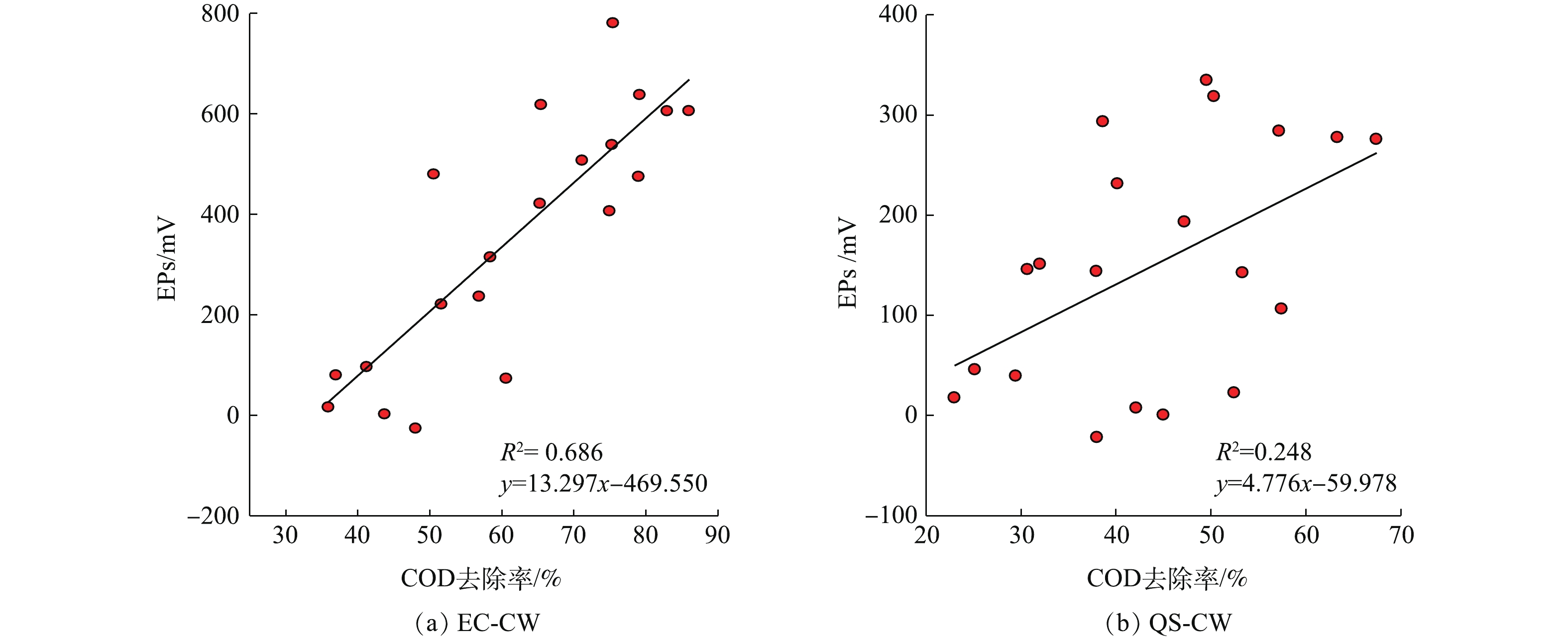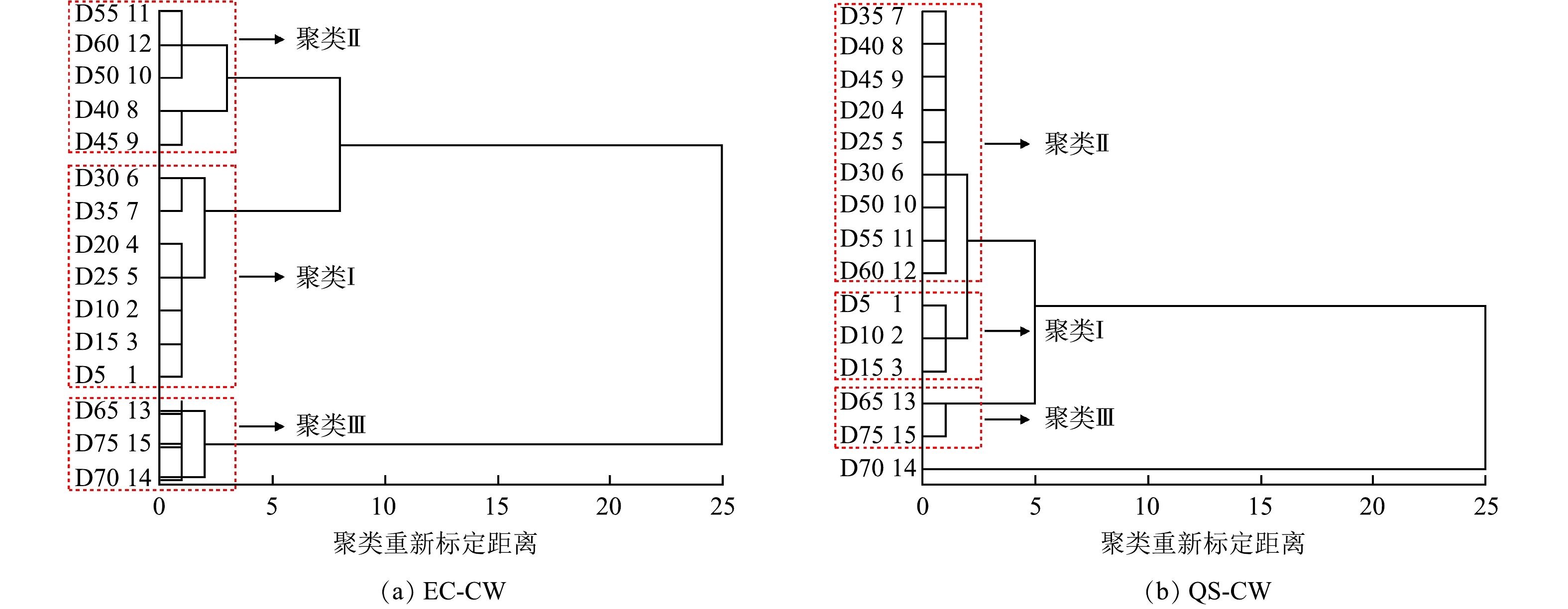-
微生物燃料电池(microbial fuel cells,MFC)是一种以微生物作为催化剂将有机物中的化学能转化为电能的技术,主要由阴极、阳极、分隔材料和外电路等4个部分组成,阳极区的有机物降解后产电细菌将电子通过外电路传递至阴极,产生的质子扩散至整个阴极区域,质子与电子在阴极与电子受体发生反应,产生电流[1-2]。人工湿地(constructed wetlands, CWs)以其底部厌氧、表层好氧/缺氧特征,具备微生物燃料电池的发生条件。这使得微生物燃料电池和人工湿地耦合技术(microbial fuel cells-constructed wetlands, MFC-CWs)在去除污染物的同时也具备产电功能[3-4]。从目前研究成果来看,MFC-CWs 虽有电流输出,但产电密度较低,污染物降解能力也未得到实质性的提升[5]。YADAV等[6]构建的MFC-CWs 产电量为15.73 mW·m−2。FANG等[7]发现的MFC-CWs 最高产电量为852 mW·m−2。TURKER等[8]得出的MFC-CWs 最高产电量为15.1 mW·m−2。
尽管碳纳米复合材料在发电效率的研究方面取得了一些重要的成果,但碳纳米复合材料的进一步应用仍面临一些挑战,特别是电极材料昂贵和能量产率低[1]。在此情况下,目前的研究开始变换思路,将电子外输转为电子的原位利用,将人工湿地的产电能力转化为加快污染物降解的源动力,以电子的内部消耗来换取净化性能的极大提升。针对如何利用电子的传递和消纳进行生物电能向净化性能转化这一核心问题,RAMIREZ-VARGAS等[9]通过具有导电能力的碳质填料的填充,将人工湿地演变为一种短路状态的微生物燃料电池。碳质填料作为电子传导通道,在无需外置电路情况下,构建出电子产出-传导-消纳的原位利用路径,在电位梯度驱动下,使得有机污染物作为电子供体得以被高效降解。导电填料人工湿地中污染物去除负荷能提高10倍,且污染物去除率较常规人工湿地有显著提高[10]。
然而,目前国内外利用导电填料填充人工湿地产生原位电场来提高去除率的研究尚处于起步阶段,反应器规模通常较小,工程应用中的人工湿地构建深度通常在60 cm以上,在此条件下,导电填料的电阻比实验装置中电阻有显著提升,加上导电填料种类的有限,自发电场能否产生,污染物净化效率能不能提高,均有待于进一步研究。鉴于此,本研究在对不同饱和状态下碳质填料的电阻率进行测定的基础上,构建了与实际工程等深的人工湿地实验装置,以探索碳质填料的导电特征及其对人工湿地污染物净化效果的影响;同时,优化水力停留时间和有机负荷对系统产电性能的影响,以期为碳质填料人工湿地的应用提供参考。
全文HTML
-
实验装置原理如图1(a)所示,现场装置照片如图2所示。分别构建导电材料焦炭人工湿地(electro-conductive material coke constructed wetland,EC-CW)和石英砂人工湿地(quartz sand constructed wetland,QS-CW)。EC-CW和QS-CW尺寸相同,均为底部进水,顶部出水,分别在反应器主体填料的顶部和底部填充粒径为2~3 cm的鹅卵石,高度均为5 cm,保证系统配水及集水均匀,填料填充完成后,其上均种植美人蕉3株。
在反应器高度为25、45、65、90 cm处分别设置取样口,考察污染物的沿程降解情况。同时在反应器中间预埋1根直径为3 cm、高度为1.2 m的高密度电极杆,电极杆上共设置16个圈状电极(以增大电极与填料的接触面积,减少实验误差),每个电极圈间隔为5 cm。
该反应装置底部为进水区,水中丰富的有机物为产电菌提供碳源,在降解的过程中释放电子和H+,电子沿着具有导电性的填料颗粒向上传导到床体顶部,在此区域,与氧气、硝酸盐等电子受体反应,生产H2O及N2。因此,反应器底部类似于微生物燃料电池的阳极区,而反应器的顶部被视为阴极区(图1(b))。
碳质填料作为电子传导通道,在无需外置电路情况下,电子在系统内部产生与传递,最终在阴极发生还原反应,从而在系统中形成短路状态的自发电极化现象。这一现象形成的自发电场驱动电子的加速产生与传递,从而提升了作为电子供体的有机污染物的降解效率,使得系统净化效果得到提升。
-
实验所用生活污水取自桂林理工大学校园集水井,其pH为7.2,化学需氧量(COD)为105~120 mg·L−1、氨氮(
NH+4 -N)为7.63~8.20 mg·L−1、总氮(TN)为25~57 mg·L−1,总磷(TP)为0.8~12 mg·L−1。启动阶段设置系统水力停留时间(HRT)为30 h,连续进水,同时测定反应器中不同断面的电位值,待反应器中电位值保持稳定时,说明系统启动成功。系统运行分为5个周期,所对应的HRT依次设置为 6、12、18、24和30 h,每周期运行时间为14 d,考察不同HRT下出水水质和系统的产电性能。随后在进水中加入乙酸钠,分别调整进水COD为300 mg·L−1和500 mg·L−1,对比有机负荷对系统出水水质和沿程电势差(electric potential difference,EPs)的影响。在实验过程中,每天测量对比系统不同高度电势变化情况。每2 d采样测定进出水及沿程水样的COD、
NH+4 -N、NO−3 -N、TP变化。 -
1)EPs的测量。本实验通过碳质填料的填充,使产电微生物富集在碳质填料颗粒表面,形成自然电场,因此,在床体中并无实际电极存在,其电场的测量无法按照常规方法进行。有研究发现,自然电场广泛存在于自然界中,是地电场的重要组成部分。它由各种岩石的接触电位差、氧化还原电势、水流穿过多孔岩石产生的过滤电势以及矿化溶液离子在岩石交界面上的扩散和岩石骨架对离子的吸附作用等所产生[11],因此,本研究采用地球物理勘探学科中对自然电场的测量方法监测人工湿地床体电场产生情况。如图1所示,高密度电极杆与外接高密度电阻率仪(WDDS-3型)相连,利用自然电场法通过测定电极杆上不同位置电极间的电势差,来表征床体不同高度电势分布情况。
2)导电性能测试。本研究选取3种碳质填料(活性炭、无烟煤及焦炭)开展实验。活性炭购于河南清之鑫环保科技有限公司,无烟煤、海绵铁和焦炭购于河南华宇环保科技有限公司。活性炭粒径为3~5 mm,比表面积为1 000 m2·g−1,填充密度为0.45~0.55 cm3·g−1,pH为8;无烟煤粒径为3~5 mm,含碳率为90%,孔隙率为53%,密度为1.57 g·cm−3,堆密度为0.947 g·cm−3;焦炭粒径为3~5 mm,真密度为1.81 g·cm−3,视密度为0.9 g·cm−3,孔隙率为35%。
为研究不同碳质填料在不同人工湿地类型及运行状态下电阻率的变化情况,对3种选定的填料分别在自然干燥、纯水充满及充满后排空,生活污水充满及充满后排空条件下测量电阻率值,以探讨填料受饱和状态及水质成分的影响,具体实验步骤如下。
不饱和状态电阻率的测定。在自制电阻率测定装置中测定不饱和状态电阻率,装置由直径5 cm的PVC管和两端的铜质封片组成,先在PVC管中填入待测填料并压实,在端口处填充硫酸铜泥浆以保证填料与铜片之间的充分接触,最后用万用表测量两端电阻。
纯水-填料饱和/(不饱和)状态电阻率的测定。待第一步测定完成后,在填充填料的PVC管中注满纯水,用生料带缠绕连接处,防止水溢出,使填料呈现饱和状态,然后用同样的方法测电阻,随后,将纯水倒出,使填料呈现不饱和状态,再次测填料的电阻。
生活污水-填料饱和/(不饱和)状态电阻率的测定。待第2步测定完成后,重新更换填料,然后注满实验用生活污水,测量饱和及不饱和条件下电阻,步骤同第2步。
电阻率换算。填料样本的电阻(R)与沿电流方向的长度(L)成正比,与垂直流方向的横截面积(S)成反比[12],如式(1)所示。
式中:R为填料样本的电阻,Ω;ρ为试样电阻率,Ω·m;L为标本长度,m;S为与垂直流方向的横截面积,m2。
由式(1)得填料标本电阻率,如式(2)所示。
式中:ρ为试样电阻率,Ω·m;L为标本长度,m;r为标本横截面半径,m;d为标本横截面直径,m。
3)水质测定方法。用紫外分光光度法(HJ-T346-2007)测定水样的
NO−3 -N;纳氏试剂分光光度法(GB 7479-1987)测定NH+4 -N;钼酸铵分光光度法(GB 11893-1989)测定TP;重铬酸钾法(GB 11914-1989)测定COD[13]。 -
使用Microsoft Excel 2010和IPM SPSS Statistics 22.0对数据进行统计分析。数据结果使用sigmaplot 12.5绘图。
1.1. 实验装置构建
1.2. 系统运行参数及采样方法
1.3. 检测方法
1.4. 数据分析
-
3种填料的电阻率如表1所示。在自然干燥条件下,3种基质的电阻率大小为无烟煤˃活性炭˃焦炭,分别为(45.8±1.9)、(31.7±5.7)、(2.5±0.1) Ω·m。一般认为,电阻率值小于10−5 Ω·m的固体为导体,大于108 Ω·m的固体为绝缘体,若在两者之间被认为是半导体[14]。因此,上述3种填料均属于半导体材料。在自然干燥条件下,焦炭的导电性能最好,无烟煤的导电性能最差。
饱和状态是人工湿地的正常运行状态。在饱和状态下(分别充纯水和生活污水)测量了3种基质的电阻率,结果表明,在饱和条件下电阻率明显降低[15],纯水和生活污水下基质的电阻率均为活性炭>无烟煤>焦炭。与纯水相比,生活污水条件下的电阻率值略高。活性炭和无烟煤的电阻率分别由(45.8±1.9)、(31.7±5.7) Ω·m (自然干燥)降低到(4.8±0.7)、(4.8±0.3) (纯水)和(5.7±0.5)、(5.1±0.3) Ω·m(生活污水)。而焦炭的电阻率,自然干燥条件下与饱和条件下的差别相对较小(表1)。
由于人工湿地通常会间歇运行,此时会处于不饱和状态。测定结果表明,无论是纯水还是生活污水,在不饱和状态下的电阻率均为无烟煤>活性炭>焦炭。焦炭和活性炭在非饱和状态下的电阻率比饱和状态下低。而无烟煤在非饱和条件下电阻率增加,这与其颗粒之间的压实度较低有关。无烟煤颗粒表面光滑、坚硬,填料颗粒接触较差,低压实密度影响其电阻率值[16]。
上述结果表明,即使人工湿地在饱和与非饱和交替条件下运行,焦炭的电阻率值也始终低于无烟煤和活性炭,具有显著差异(P<0.05)且相对稳定。因此,后续实验以焦炭为基质构建人工湿地实验系统,并与传统石英砂(电阻率为1 018 Ω·cm)人工湿地系统进行比较,研究导电材料对有机物去除的效果。
-
EC-CW和QS-CW系统中EPs和COD的沿程变化如图3所示。EC-CW中的COD进水平均值为100 mg·L−1,在水力停留时间为6、12、18、24和30 h时,在5~80 cm深度处,2电极之间的EPs分别为(637.46±89.47)、(780.30±24.96)、(637.46±89.47)、(605.29±25.66)和(605.47±29.41) mV。由于电子供体数量的原因,EPs随HRT由6 h增加到12 h而增加,但随HRT由12 h增加到30 h而略有下降。在此过程中,随着HRT由6 h提高到30 h,EC-CW的COD去除率由65%逐渐提高到78%,出水COD最小值在25 mg·L−1以下,显著低于进水值(P<0.05)。出水满足《城镇污水处理厂污染物排放标准》(GB 18918-2002)一级A标准。
如图3(a)和图3(b)所示,在EC-CW中,当床体高度为0~40 cm时,EPs为-17~27 mV,显著低于40~80 cm处的EPs。其原因是,由于床体底部为厌氧/缺氧区,作为电子供体的有机物浓度较高,而电子受体较少,有机物在这个区域被微生物迅速氧化。有研究[7,17]也表明,超过50%的耗氧有机物(以COD计)在40 cm深度以下被去除。由此推测,EC-CW底部区域可视为阳极区。此后,随深度的增加EPs亦有所增加,在由40 cm增加到80 cm的过程中,由于植物根系释放的氧气使电子受体数量增加,由底部阳极区产生的电子与电子受体发生反应,使EPs逐步升高。
以往的许多研究[18]表明,HRT的变化会影响阳极富集的电活性菌、产甲烷菌等厌氧菌的多样性和活性,进而影响人工湿地的阳极电位。如图3(c)~(e)所示,随着HRT的降低,EC-CW的阳极区逐渐减小,甚至小于25 cm的深度。由此推测,较短的HRT可造成较高的水流速度,对床体稳定的厌氧/缺氧区产生直接影响。
值得注意的是,虽然石英砂的电阻率很高,但在QS-CW系统中也监测到了EPs(图3)。当系统HRT为6、12、18、24和30 h时,在5~80 cm深度处,2电极之间监测的EPs分别为(334.46±15.82)、(318.17±7.90)、(283.75±17.21)、(275.66±25.36)和(277.42±12.76) mV。EPs较EC-CW系统低但稳定,没有呈现出明显的阳极区,与EC-CW系统存在显著差异(P<0.05)。如前所述,自然电场在自然界里广泛存在,故在QS-CW中,水流通过石英砂颗粒填料时由于阴阳离子吸附作用等,形成电动势、吸附势、扩散势,会在任意两点之间产生的电位差[19]。此外,在图3中还可以发现,在QS-CW系统中,EPs随HRT的降低而略有增加。其原因可能是,由于HRT降低使流速增加,吸附的阴阳离子数量增加的缘故。
对于QS-CW中有机物的去除,HRT分别为6、12、18、24和30 h时,COD去除率分别为38%、40%、47%、52%和57%,比EC-CW低21%左右。有研究[20]也表明,在填充导电填料人工湿地系统中,底部厌氧/缺氧区释放的电子在不借助外电路的情况下,可沿着导电填料颗粒向上传递,类似在短路条件下运行,电势的形成促进了电活性微生物的富集,从而加速消耗作为电子供体的有机物,避免自由电子在底部的累积,进而发生的甲烷化反应。
-
在2种进水COD(300 mg·L−1和500 mg·L−1)下EC-CW和QS-CW中有机物去除率和EPs的沿程变化如图4所示。当HRT为30 h、进水COD 为300 mg·L−1和500 mg·L−1时,在5~80 cm深度处,EC-CW和QS-CW对应的2电极之间的EPs分别为(456.75±22.60)、(432.00±41.80) mV和 (238.51±36.91)、(229.03±7.27) mV。与图3(a)中所示的EPs相比,在相同的HRT(30 h)下,随着COD由100 mg·L−1增加到500 mg·L−1,EC-CW中的EPs逐渐降低;而QS-CW系统中随着COD的增加EPs增幅不大,这进一步证明了QS-CW中的EPs受微生物作用产生的氧化还原电势的影响较小,而是一种受水流速度影响的自然电势。
前人研究[21]中也观察到,EC-CW 中COD的负荷对CW-MFCs的性能有很大的影响,系统EPs随进水COD的提高而明显下降。COD应满足为阳极氧化提供足量的有机物,同时到达阴极的有机物足够少。因为较多的COD到达阴极将刺激异养菌的繁殖,使阴极需氧量增加,从而极大减少了完成电路循环所需的电子受体数量。同时,阴极上异养生物膜的形成,限制了反应物与电极和电极产物的传质过程[22]。
当COD由100 mg·L−1增加到300 mg·L−1时,EC-CW中的COD去除率由78%逐渐增加到82%(图3(a))。这是由于COD的升高为阳极氧化提供了足够的有机物,出水COD为40 mg·L−1(达到了《城镇污水处理厂污染物排放标准》(GB 18918-2002)一级B标准),也表明到达阴极的耗氧有机物数量较少。当进水COD由300 mg·L−1进一步提高到500 mg·L−1时,平均去除率下降到62%,阴极出现较多的有机物,出水COD升高至210 mg·L−1,表明进水COD过高,影响了床体内部电子产生与传递过程。对比来看,在较高的进水COD负荷下(500 mg·L−1),EC-CW对COD的去除率仍优于QS-CW,比QS-CW系统高出16%左右。
-
除有机物外,还对比了2个系统对氮磷等污染物的净化效果,结果如图5所示。由图5可知,EC-CW对
NH+4 -N、NO−3 -N、TP和COD的平均去除率分别为33%、60%、19%和83%;QS-CW的平均去除率分别为29%、49%、21%和62%。在EC-CW系统中,COD和NO−3 -N的去除能力较高,但对比2个系统,NH+4 -N和TP的去除率却基本相当。综上所述,导电基质的填充使EC-CW在短路模式下工作,作为电子供体的有机物,在阳极区能够被电活性微生物加速氧化;硝酸盐可在阴极区作为电子受体被加速分解,因此,呈现出较高的COD和NO−3 -N的去除率[23]。但NH+4 -N去除率的提高需要充分的硝化过程,而焦炭的填充不能使系统DO增加,因此,对氨氮去除效果影响不大。此外,人工湿地中的TP主要是通过沉淀和植物吸收等物理化学过程去除的,焦炭以其较大的比表面积,尽管在短期内其吸附容量高于石英砂,但从长期运行效果来看,其对总磷的去除率没有持续增加。2个湿地系统中COD去除率与EPs的线性拟合结果如图6所示。在EC-CW系统中,其线性拟合较好(R2=0.686),而QS-CW中线性拟合较差(R2=0.248)。这进一步说明EC-CW中有机物的降解与自然电场的产生有关。
将2个系统沿程电势进行了聚类分析,以探讨床体自然形成的两极分区,并体现床体中的氧化还原特性,聚类结果如图7所示(图中纵坐标1、2、3、4、5等表示环形电极的编号,D5~D75表示各电极所对应的反应器深度)。由图7(a)可以看出,在EC-CW系统中,高密度电极杆上的15个环形电极监测的EPs聚为3类:5~35 cm (D5~ D35)处电极的EPs在聚类重新标定距离(rescaled distance cluster combine)为1 的水平上聚类在一起,为第I类也即1~7号电极(对应的深度为5~35 cm)聚为一类;第II类包括埋深在40~60 cm (D40~D60)处的8~12号电极;而第III类包括埋深在65~75 cm (D65~ D75)处的13~15号电极。由此推测,聚类Ⅰ、聚类Ⅱ和聚类Ⅲ分别为阳极区、过渡区和阴极区[3]。阳极区是电活性微生物降解作为电子供体的有机物的主要区域;而阴极区是电子受体消纳传递来的自由电子的主要区域;过渡区为阴阳两极的过渡区域。EC-CW系统较好的聚类说明其床体中有较好的氧化还原区域划分,也验证了前人通过填充导电填料来扩展电极空间,进而形成短路模式人工湿地系统,提高有机物去除效率的设想[24]。在QS-CW系统中,在聚类重新标定距离为1 的水平上15个电极分成3个类群(图7(b))。聚类Ⅰ、聚类Ⅱ和聚类Ⅲ深度分别为5~15 (D5~ D15)、20~60 (D20~ D60)和65、75 cm (D65、D75),电极编号分别为1~3、4~12、13,15。与EC-CW相比,阳极区和阴极区较小,过渡区较大,这说明系统中没有明显的氧化还原空间划分。
-
对于常规生活污水而言,EC-CW人工湿地在HRT为30 h时,实验出水即可满足《城镇污水处理厂污染物排放标准》(GB 18918-2002)一级A标准。在相同进水条件下,焦炭填料人工湿地比石英砂填料湿地去除率提高了约21%。由此推算,在实际工程中,焦炭填料湿地能够减少近20%的建设规模。虽然焦炭填料费用较石英砂高,但考虑到征地成本和建设成本,焦炭填料湿地的经济性更好。
2.1. 不同填料在不同环境中的电阻率大小
2.2. HRT对电势差及有机物去除率的影响
2.3. 有机负荷对系统EPs及有机物去除率的影响
2.4. 氮磷的去除
2.5. 处理效果和经济性核算
-
1)实际人工湿地通常处于饱和/非饱和或二者交替运行状态,根据对无烟煤、活性炭和焦炭在自然干燥、饱和及不饱和条件下的电阻率测试结果,发现焦炭的电阻率相对较低,且在不同运行环境中较为稳定,为0.8~2.5 Ω·m,其为较好的导电填料。
2)碳质填料-焦炭人工湿地中最大EPs达到605~780 mV;聚类分析结果表明,该床体中氧化还原分区明显。随着HRT的变化及有机负荷的波动,该系统下COD去除率与EPs呈现的线性关系较石英砂系统好,石英砂湿地中EPs较低但相对稳定。
3)在不同水力负荷和有机负荷条件下,焦炭填料人工湿地对COD的去除率显著高于石英砂填料人工湿地,去除率可提高16%~21%,但两者氨氮和总磷的去除率差别不大。




 DownLoad:
DownLoad:

